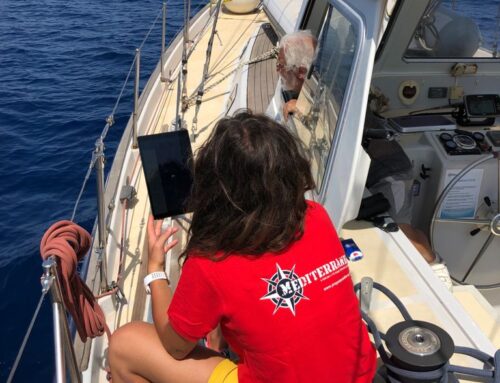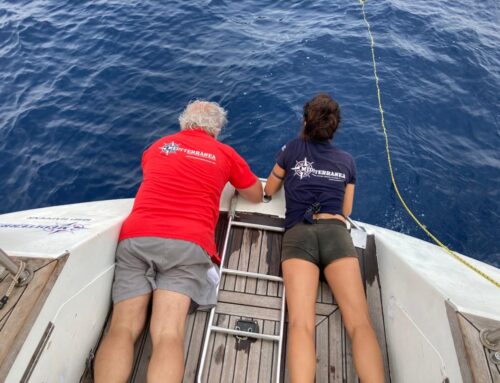(by Simone Perotti)
Chef Musa Dagdeviren has a smile like a Cheshire cat. He has a thick curved Turkish-style moustache, quick honest eyes, and one understands that he is as curious and courteous as he is determined and decided. Our food-blogger friend Ayfer Tuczu Ünsal introduced him to us, speaking very well of him (“I just love taste, and it is him I go to if I have a doubt, he is very good!”), and indeed she has not exaggerated.
Musa (that is to say Moses) is well-known all over the world, he knows the cuisines of many important countries, including ours, where he is often invited to teach. For example, he has been asked by Slow Food to hold a ten-day course in Turin in the near future.
We want to discuss flavours, taste, contamination, differences and similarities in the large and fascinating melting pot of the Mediterranean cuisine, and Musa doesn’t wait to be asked twice. “Turkey is not a uniform nation from a gastronomical point of view Tangible signs have remained here from when dozens of ethnics groups, influences, substances and aromas have passed through and lived here. That is why our cuisine is such a rich one. I’m from the South-East (like Ayfer Tuczu), where we have acres and acres of olive trees that very probably were the first olive trees in the Mediterranean, given that the olive tree comes from Mesopotamia.”
I listen to him with great pleasure as he speaks, because his face is a very expressive one, filled with smiles and grimaces, and we seem to understand what he is saying even before Ayfer has translated for us. We learn something about him: he is the son of a long line of bakers, and started off in life with a small bread bakery on the Asian shore, then his wife, who sounds like a very smart woman, encouraged him to do more, because she knew how well her husband cooked. And so Musa opened his first restaurant, again a tiny one, and today has three huge three and four floor restaurants, in the most noisy and colourful street of Kadiköy, a street-market of fishmongers and vegetable sellers, delicatessens and clubs, which is in itself intoxicating and whips up your appetite as you walk towards his CIYAs, all with the same name, one next to the other.
Following the thread of “Basil, mint and garlic” by Jean-Claude Izzo (who wrote a short essay inspired by these three flavours, the three flavours, which for a person like him, who comes from Marseilles, identify the soul of the Mediterranean) we ask Musa what his are. A concise debate follows: “I would say tomato, chilli pepper and eggplant, because I do not know even a single Turk from the South and West coast that does not adore these three flavours, but in the North, on the Black Sea, they are virtually never used. There they love potatoes and peppers, and hate tomatoes. If I want to think of something that everyone eats however, that is typical of our traditions, then I have to say bran, yoghurt and lamb. So how should I answer? ” We tell him that we always ask each chef to answer this question taking into account his gastronomic culture and that of his country, and thus considering the representativeness of the three flavours only in part, giving an interpretation, and taking a stand. He thinks about it again, and asks Ayfer and us what we mean, trying to understand the exact meaning of the cultural game we want to play, and from which we would like to create a final classifcation after five years of travelling. Then it seems to grasp the point: “Okay, I get it, in that case I have no doubts: olive oil, garlic and bread.” Very interesting. Our journey will seem to be an authentic pantry, once we have met all the 29 chefs.
He then puts on his chef gear and starts to prepare his recipe. As we did with Moreno Cedroni, who was the first, at the time of our departure, and with Stephanos Stefanidis, in Thessaloniki, we asked Musa Dagdeviren what recipe he thinks represents the final and perfect synthesis of Turkey’s relationship with the Mediterranean. A question that must have bothered him and put him to the test because, we discover, that he has once again consulted Ayfer, and she simply replies with some kind of equally brief epigraph: “A plate from the rustic cuisine, there is no doubt of that.” Musa must have however questioned himself long and hard about a very common doubt in the Mediterranean: meat or fish? Then he makes up his mind, and prepares the Mualle (which reads muallé) for us, a dish made with beans and vegetables which comes from Antioch. And one that is rather particular: it is cooked by building a sort of castle in layers, to ensure a uniform and gradual exchange between the different ingredients. Something similar to what the Chileans and Argentinians do in Tierra del Fuego withCuranto, when they create layers of fish, shells and vegetables that are cooked in an oven in the ground. And so that we discover that in Turkey they use Tandir ovens (tandoori, like in India) and that they use the same name for the ovens in the ground, covered with river stones, but in which they cook layers of lamb and vegetables seasoned with herbs: “And underneath we place a layer of raw bulgur, which absorbs the fluids of the lamb and cooks slowly.” In the matter of a moment, we travel around the world from India to South America and the Levantine Sea. An overdose of contamination that fascinates me in an extraordinary way.
Musa starts to prepare his dish, and explains that it is a main-course, but may also be used as mezé (starter) and may be served with meat or fish. “That is why I chose it: it is perfect for vegans, vegetarians, people with religious beliefs, and is very versatile, but above all it is a synthesis of vegetables, legumes and flavours that identify to perfection the cuisine of the South East, which I consider the best in our country. ” Ayfer cuts in: “He was born in a place close to my town, Gaziantep. Namely the capital of Turkish cuisine.” We laugh, but I get the feeling that they are quite serious about this.
Musa chops yellow onion, garlic, long and narrow green chilli peppers (which are sweet), and cherry tomatoes, which are quite big, into fairly large pieces. He flambés them by adding apparently large doses of sommaco[1], red chilli pepper, dried mint, black pepper, cumin, a pomegranate based sauce, olive oil which is similar to our oil from Liguria and a ladle of very liquid tomato sauce, cooked separately. He then tests if there enough salt, adding two extra very large pinches. After allowing the ingredients to cook but not brown, for about ten minutes, he takes a stainless steel pot and builds the castle consisting of four alternating layers: the first layer consists of a part of the vegetables; the second is a two centimetres layer of raw eggplant from which he peels off the skin in strips (leaving half of the skin on); the third layer consists of big green half-cooked lentil; and the fourth is a thick layer of parsley and twigs of fresh unchopped mint. After forming the first four layers, he starts again from the first, and does so for another five times to fill the pot.
Finally, he presses the layers with the palm of his hand, squeezing them down firmly, without upsetting the different layers. He turns up the heat, and places a plate facing down on the top layer and then a pot filled with water on the top, to keep the structure under a moderate pressure.
You cook this, he explains to us, at a lively heat for about ten minutes, then you turn down the heat (he actually moves the pot from the gas cooker to a charcoal fire which is half covered with ashes) and let it cook. “Turkish cuisine is slow, always!”. And in fact we wait for at least an hour before the Mualle is ready.
And the result is wonderful. An ensemble of legumes and vegetables, which are just a little spicy, where everything has melted to perfection, no taste prevails, and where the spices – which are not as excessive as we had imagined – are perfectly balanced between sour and salty. A perfect delight.
When we say our goodbyes, after having lunched together and chatted about food-related stories and legends, we are well satisfied. Our journey through the flavours of the Mediterranean, now in its third stage, is full of charm and suggestions, but above all, it has only just begun …
[1] Sommaco, which is called sumac here. It is the fruit of a shrub, which is harvested before it is fully ripe and allowed to dry. The fruit is dark red, and is generally pulverized. It was used in ancient Rome and during the Middle Ages, and is currently one of the main spices used in Middle Eastern cuisine. It has an acidic flavour and is used to lighten meat or fish dishes, or may be used as an alternative to lemon and vinegar. It is also used in some mixtures including Zathar






Leave A Comment